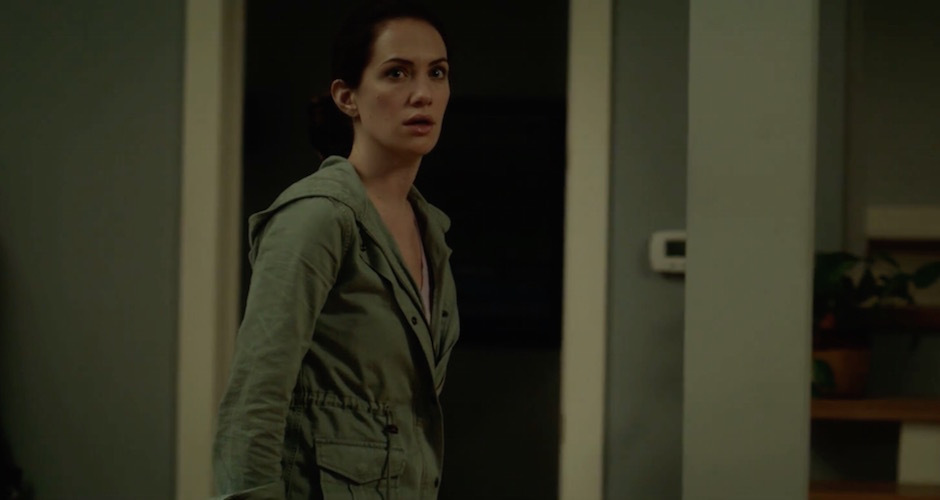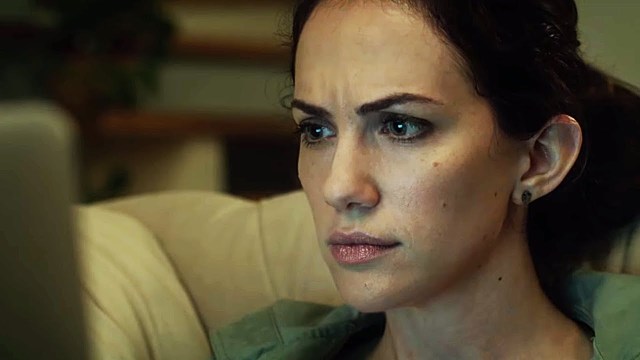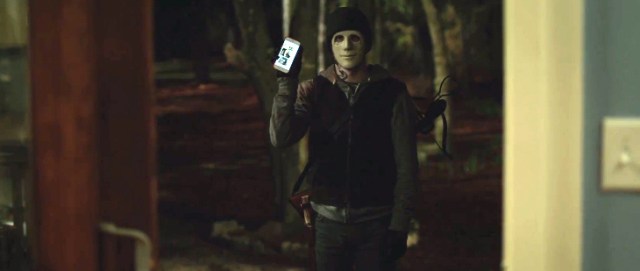Not exactly Netflix and chill, the new feature film Hush is more likely to have you checking your locks before bed. The SXSW film was picked up before the festival premiere as a Netflix original (available this Friday). The ultra-low budget feature ($70,000) is the second collaboration of newlyweds Mike Flanagan and Kate Siegel (they also made Oculus) and their first time co-writing a screenplay.
Siegel plays a deaf (and mute) mystery writer living alone in a secluded home (with just her cat and distant neighbors for company). One night, an intruder breaks into her home to terrorize her, forcing her to survive by her wits as a writer. Logically, the film is often without dialogue (its 87 total minutes contain less than 15 minutes of dialogue), which required them to take a creative approach to the sound design. We spoke about making a dialogue-light movie for modern audiences, the experience of writing a horror movie while dating, and turning nice guy John Gallagher Jr. into a super creepy villain.
Lesley Coffin (TMS): It’s funny, because right before I saw the film, I talked to John Gallagher Jr. for 10 Cloverfield Lane, and I’m just so glad it wasn’t the other way around, because he’s pretty scary in this.
Kate Siegel: We love John, and he is the sweetest guy, so I’m just so happy people find him scary in this movie.
Mike Flanagan: When he arrived we were talking about what he had been up to before this and he was like “I was making a little thriller. Just a little three person chamber piece.” And then we saw the trailer and realized what he’d been talking about. But he is the coolest guy and such a sweetheart. We both loved working with him.
TMS: As co-writers, how did the idea for the movie come about? We you looking for a project to do together or did you just think of the premise first?
Siegel: Mike and I were out to dinner and talking about the types of horror movies we love, because we both love horror movies and thrillers. And I mentioned how much I love Wait until Dark, because I’d just seen a stage version at the Geffen. And we started talking about what we love about making movies, the process of it, and Mike said “I’ve always wanted to make a movie with little to no dialogue.” And I mentioned this recurring nightmare I have about seeing the face of an intruder at my door, which I thought would be such a scary image to have in a movie. And then the appetizers came and we decided to combine those two things, the scary face in the window with little to no dialogue. And I honestly think that by the time dessert had been served, we had the film essentially outlined. But at that point, we also knew the film would be covered in red flags. The protagonist, a deaf and mute woman, was not traditional, so it could be labeled almost an art house film, even though it’s a horror film. But Mike’s worked with Jason Blum before and thought he would understand the approach we were taking better than anyone. I don’t think we intentionally kept it small, but that approach fits this movie, because if we had gotten into even a six or seven million dollar movie, we would have been asked to make compromises on our initial ideas and add more dialogue.
Flanagan: They would have asked that she not also be mute or asked for more voice over. And Jason understood the premise and knew it could get made under-budget. So he just trusted us to make the movie we wanted to make.
TMS: Did you have the sound design in the script or did you create most of that during editing?
Flanagan: No it was all laid out in advance. I thought about it more on this movie than on any other I’ve worked on, because of how long the sections without dialogue are, you really notice how sound and music adds to a film. I knew I wanted it to be kind of extreme and almost uncomfortable to sit through for the audience, because you want them to feel something akin to Maddie’s experience. And you can’t create that sensation for a predominately hearing audience just by removing the sound because there is always ancillary sound in a room. So you have to create sound that is uncomfortable to sit through, and adds to your sense of anxiety. Even the sections of the movie where we are “hearing” Maddie’s silence, we didn’t just turn off the sound, it’s actually a sound and actually one of the most complicated aspects of the film. I’m so grateful that we were picked up by Netflix, but it is unfortunate that audiences won’t have a chance to watch it in theaters with the full impact of the big sound system, especially after the experience at SXSW when we played it at the Alamo Drafthouse. People seemed to be jumping out of their seats because of the sound. But people have great sound systems in their home theaters now and the movie seems like the perfect home alone watch if you want to scare yourself.
TMS: I watched it at home because I couldn’t make the screening during SXSW. But, I did watch it late at night, alone, with my cat next to me, in bed…and I had trouble sleeping because it really makes you think about the home invasion fear that is magnified when you live alone. Did you have those fears?
Seigel: All the time. That is really where that dream I had comes from I think. The fear of someone coming into your home is a huge fear, but I think it’s an especially intense fear for women. You realize that for the most part, women living alone is a relatively new social norm. It used to be women lived at home until they married, and even once they got out on their own, most young women had roommates. But now more and more women live alone for a long time, and just have to learn to cope with that anxiety. And I just love that your cat was sitting there too because Maddie has her cat. And I don’t want to get into stereotypes but a lot of women who live alone have pets, but most have smaller animals like cats, rather than big guard dogs that will protect or alert you of an intruder. So that all feels right for creating that shared fear and anxiety with our main character.
Flanagan: Sorry about keeping you up though. But there have been so many home invasion movies over the years, and our producers did the Purge and The Strangers. So the genre is deeply disturbing for a lot of people, but focusing on the vulnerability of living in solitude allows this film to stand out.
TMS: What did you do to simulate the inability to hear?
Seigel: I wore ear plugs and noise canceling headset on set between takes and when we were in pre-production. But when it came time to shoot the film, we had such a time crunch and the Steadicam operator was so close to me, I needed to hear auditory cues and hear things going on around me while filming. So I just had to use meditative focus, to act as if I didn’t hear anything but still listen for instructions and be aware of my surroundings. There were a couple of scenes where something loud is happening behind me, and I assumed while writing I could just put earplugs in, but the camera was so close, we couldn’t do that. But we ultimately didn’t need to.
Flanagan: I was amazed at how well she did that, because hearing is an automatic response, and you can brace for something you know is coming and ignore familiar sounds, but usually a new sound you just react to instinctively, even if it’s just flinching. When John had to break the door with a crowbar, we only had one door. So we couldn’t give Kate a practice run to prepare. But she ultimately didn’t need one, and she did the whole scene without flinching even once.
Seigel: And the third smash was my cue to stand up, so I had to listen for that. So as an actress I had to listen, but as a character I had to shut all that out.
TMS: There are a few times when we hear Maddie’s voice, in voice-over, when she’s thinking through different scenarios. I would imagine that’s the most fun part of writing a thriller as a team, thinking about different scenarios and imagining how they will play out in detail.
Seigel: A lot of the sceneries Maddie writes in her book are rejected ideas from our own script, and like Maddie, we realized where the plot holes were by playing them out, and write ourselves into a corner. We were constantly shooting each other’s ideas down because even if they were a good idea, the other one knew it wouldn’t workout down the line.
Flanagan: And we would act out some of the scenarios at home to see if we were going in the right direction and how they would play out. We had a good time.
Seigel: Scariest time of my life. We basically just scared each other for months.
TMS: I don’t think it’s a spoiler to say that John takes the mask off really early in the film, which is unusual for a home invasion movie. Which version of the invader did you find scarier, the masked man or the man when you see his face?
Flanagan: The mask we had made looked great, but the masked man is a trope that has been used in a lot of home invasion movies, even when they ultimately reveal the person behind the mask at the end. And we didn’t want there to be a question about who he is or do they know each other. We never know why he’s doing it, and John says that upfront when he reveals his face. So once we’ve got that out of the way, the focus is on Maddie and how she will survive, rather than the mystery surrounding who he is.
Seigel: I also think that it ultimately is scarier and more effective to see the face and always have it in your head, he’s real and he’s a person. He isn’t a monster, he isn’t an a masked entity like Jason or Michael Myers. He is a human being who can be killed, but he’s a human being trying to do something horrific to another human being. And that idea, that a person is capable of that mindset, is much scarier.
Flanagan: Also, it would have been a shame to not see John’s face for that long because he is so expressive and can do so much without speaking. He’s really good at being evil, even though he’s one of our favorite people.
Lesley Coffin is a New York transplant from the midwest. She is the New York-based writer/podcast editor for Filmoria and film contributor at The Interrobang. When not doing that, she’s writing books on classic Hollywood, including Lew Ayres: Hollywood’s Conscientious Objector and her new book Hitchcock’s Stars: Alfred Hitchcock and the Hollywood Studio System.
—Please make note of The Mary Sue’s general comment policy.—
Do you follow The Mary Sue on Twitter, Facebook, Tumblr, Pinterest, & Google +?










